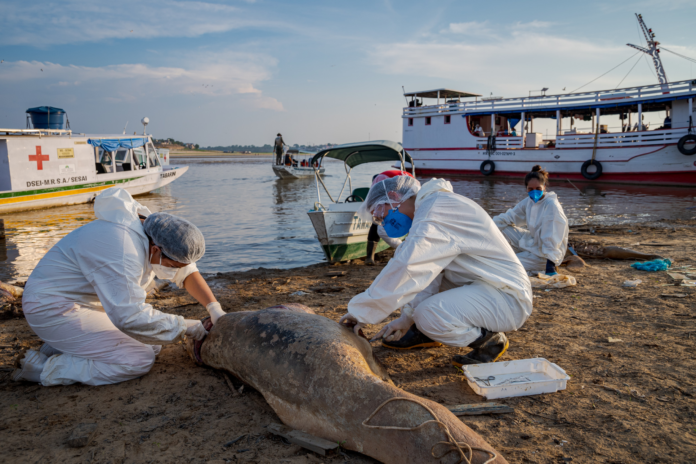Some 153 dolphins have died in a single week in a Brazilian lake, 10 percent of the lake’s entire dolphin population.
The Lake Tefé dead were made up of 130 pink dolphins and 23 tucuxi dolphins, both of which have declining populations and are listed as “endangered” on the International Union for Conservation of Nature (IUCN) Red List of Threatened Species.
Lake Tefé’s water temperatures soared to a staggering 102.38 F during the last week of September, when the dolphins were found dead in these huge numbers, alongside hundreds of dead fish, according to a statement from the Mamirau Institute for Sustainable Development (IDSM) and environmental group WWF-Brasil. The average water temperature of the lake is usually around 89.6 F, but has spiked massively due to intense drought.
Image of one of the dolphin carcasses. 153 dolphins were found dead in a single week due to the intense temperatures in the lake. © Miguel Monteiro / WWF
“What is happening at Lake Tefé is appalling. The impact of the loss of these animals is enormous and affects the entire local ecosystem”, Mariana Paschoalini Frias, conservation analyst at WWF-Brazil, said in a statement.
Pink river dolphins, also known as Amazon river dolphins, are the largest species of river dolphin, reaching up to 8.2 feet long. These dolphins gain their characteristic pink color from repeated abrasion of the skin during aggressive interactions with others of their species.
“In addition to disorderly tourism, river dolphins face several threats like accidental catches in gillnets (bycatch) … population fragmentation, habitat loss and genetic diversity by hydroelectric dams, contamination by mercury and other pollutants, direct conflicts with fishermen,” Frias previously told Newsweek. “All river dolphin populations in the world are declining in numbers, and it is not different in the Amazon (Bolivia, Brazil, Colombia, Ecuador, Peru, Venezuela and Guyana).”
The water in Lake Tefé was tested by local environmental consultancy Aqua Viridi, who found a large amount of algae Euglena sanguinea. This algae makes a toxin that often kills fish. However, necropsies on the dolphins did not reveal that the algae or its toxins caused their death, nor did viral or bacterial pathogens, meaning that the driver of the mass death is likely the abnormally warm water temperatures.
“[Dolphins] are considered ‘sentinels,'” Frias said. “In other words: they are indicative of the health of the environment where they live. What happens to them is reflected in the other species that live around them, including humans.”
The extreme drought in the region has also led to dramatic declines in water levels, which is devastating for communities that use the waterways as major routes of transport: the city of Manaus, the capital of the state of Amazonas at the junction of the Amazon and Negro rivers, reached its lowest water levels in 121 years on Tuesday.
Stock image of a pink river dolphin. ISTOCK / GETTY IMAGES PLUS
Conservation efforts at Lake Tefé are attempting to prevent further dolphin casualties from the heat, physically blocking off of the hottest regions of lake and moving the remaining dolphin to deeper, cooler waters.
“We formed a huge coalition to help collect carcasses, monitor live animals in critical areas of low depth and high temperatures, collect and send biological and water samples for analysis. An entire effort to get to the root causes of this unprecedented event,” Frias said.
“In our studies on Amazonian dolphins, we found that they suffer from various pressures, such as predatory fishing, mercury contamination and the impact of hydroelectric plants. But these events in Tefé show that more research needs to be carried out on how they will be affected by constant climate change.”
Do you have an animal or nature story to share with Newsweek? Do you have a question about dolphins? Let us know via science@newsweek.com.




